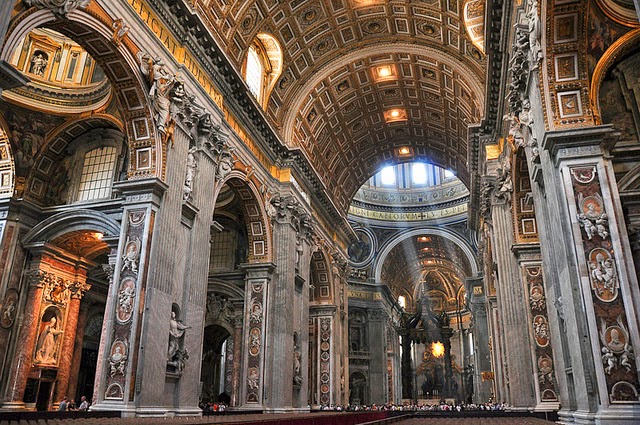When optimistic Catholic ecumenists talk about “Visible Unity” between, let’s say Anglicans and Catholics or Lutherans and Catholics what do they mean? They must imagine that it is possible for the Anglican Church or the Lutheran Church to come into a new relationship with the Catholic Church in which they are visibly, really integrated into the Catholic Church’s hierarchical structure.
How might such a thing be possible? The example exists with the Eastern Rite Catholic Churches which retain their own liturgy and customs and autonomous governance while enjoying full communion with the Holy See. This kind of unity, however, with churches of the Protestant Reformation, is impossible because these churches have formally lapsed into heresy and schism in a way that the Eastern rite churches never have.
However, there is a deeper problem: Protestants don’t actually believe visible unity is possible because they do not believe a “visible” church is either possible or desirable. To understand this Catholics should understand what Protestants believe when they say the creed and affirm their belief in “One, Holy, Catholic and Apostolic” church. They believe that church is invisible. To put it simply, “That One, Holy, Catholic and Apostolic” church is made up of all true baptized believers, and the congregation of that church is known to God alone. All the visible denominations and churches are man made institutions that have their historical foundations and their structures of governance, their traditions of worship and local customs, and all these visible things are essentially inconsequential. They don’t matter. That’s why Protestants are not too bothered by the existence of 35,000 different denominations. In fact many of them think, “The more the merrier.” If there are more fishing boats more fish will be caught.
Anglicans, for all their charade of being Catholic, are really of the same mentality. Within the Anglican Church there are multiple sub-sets like mini-informal denominations. You have Anglo Catholic, Broad Church and Evangelicals. Then you have subsets of the subsets: Evangelical Charismatics, Prayer Book Evangelicals, Anglo Catholic Charismatics, Liberal Evangelicals, Liberal Anglo Catholics and on and on.
The Catholic Church, on the other hand, teaches that the invisible church does exist, and it is the church of all true believers known to God alone. However, that church subsists in the Roman Catholic Church which was established by Jesus Christ on the Rock which is Peter. It is visible inasmuch as there is a headquarters in Rome, Dioceses and parishes around the world, a visible priesthood and visible, verifiable sacraments. If you want to find the church Christ founded you can say with confidence, “Here it is. Here it has been for the last two thousand years. It is verifiable in history and verifiable here and now when you go to Mass.”
Protestants simply don’t believe in such a visible church. However, it is somewhat more complicated than that because, while Protestants don’t believe in a visible church most of them don’t know they don’t believe in it. In fact, most of them don’t even realize that some people do believe in the reality of a visible church. It’s not that they don’t believe it. It doesn’t even come on their radar. They don’t know it is even a possibility because their bias against the Catholic Church is so deep in their Protestant genetic code.
And it is even more complicated, because although they don’t believe in the visible church and don’t even know such a thing exists, many of them in goodwill like to “feel” that they are connected with the ancient church which they know was, at one point, “One, Holy, Catholic and Apostolic.” So they “feel” united when they do things in a Catholic way or when they read St Augustine and “feel” connected to him. Then when they go to a Catholic Mass or visit Rome they “feel” like they belong to that church they see all around them.
Therefore the unity that exists is one of subjective feelings mixed with optimism for the future, but this is not a basis for real, objective visible unity.
Finally, I find it confusing that the Holy Father and other Catholics, who are clearly blithely (or willfully) ignorant of the reality of the Anglican Church continue to ignore or downplay the achievements of the Anglican Ordinariate Communities. Do Anglican and Catholic leaders wish for visible unity? The pathway has already been pioneered by Benedict XVI’s amazing ecumenical accomplishment. Yet, it must be said that the Anglican hierarchy has greeted this development with undisguised scorn and rejection. The Catholic hierarchy (at least in England) has welcomed the Ordinariate rather like a youngster greets a dish of broccoli. “I know its good for me, but do I have to?”
Do Catholics and Anglicans really want visible unity? Open wide the doors to the Ordinariate. Anglicans–make some of the churches you don’t need available for the Ordinariate congregations to worship in. Catholics? Encourage those priests and people who have already established “visible unity” between Anglicans and Catholics. Don’t marginalize them, laugh at them behind their back and exclude them.






Leave A Comment
You must be logged in to post a comment.